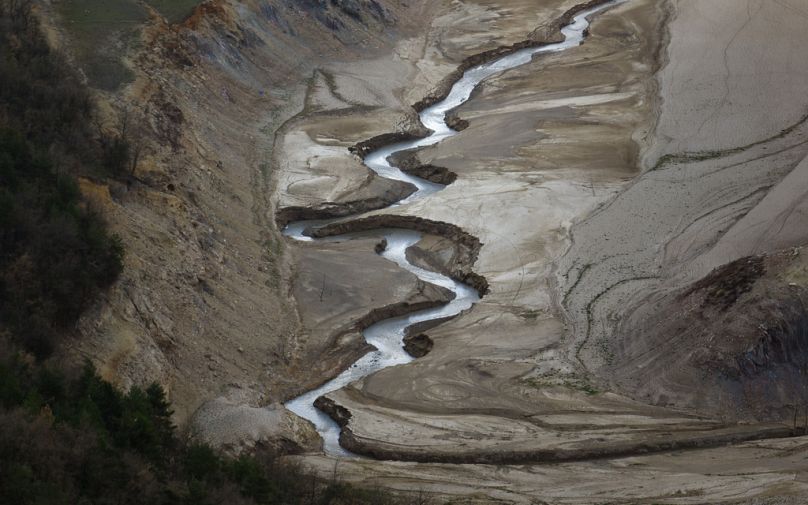In some European countries, we will need to stop thinking that we have an automatic right to cheap, plentiful water which we can use to clean our streets, wash our cars, or fill our swimming pools whenever we wish, Mark Smith writes.
If we want to solve it, Europe’s water crisis should be treated at the local level
Last Thursday, the Spanish government held an extraordinary meeting about the economic impact of the drought currently ravaging the country.
Spain has experienced drought more severely and for longer than other European counties, but the whole of Europe is set for a worse summer drought than that of 2022, already its worst for 70 years.
On the face of it, it might seem obvious that our leaders should be looking at this drought as a pan-European problem or even a pan-European, Middle Eastern and African one.
East Africa is currently ravaged by drought, with 700 million people in the region anticipated to be displaced by water shortages by 2030.
Meanwhile, low-lying desert countries like the United Arab Emirates are being menaced by rising sea levels and increasing their reliance on high-emitting desalination programmes.
Is water in Europe really that abundant?
Climate change is increasingly manifesting itself as a water crisis; in the case of Spain, it is droughts, but we’re also experiencing more floods and storms.
People in Andalucia are certainly experiencing the climate crisis for what it is — a water crisis.
Until we reverse the global emissions that are causing climate change, the medium-term solution for Spain and Europe involves managing water. This is where the solution becomes much less global.
When it comes to water management, we hear a lot about water scarcity issues. But in fact, what we mostly have is overconsumption combined with water access problems.

Indeed, there is a prevalent attitude in Europe that water is plentiful and cheap, which persists right up until it is no longer available.
There are definitely parts of the world that are genuinely running out of water. Andalucia, home to the only desert in the EU, is one of them.
But even in southern Spain and in other desert regions such as parts of East Africa, water exists, and we know its location. We just don’t have access to water — or rather, we don’t have clean access to it.
Drought is not resolved by pumping more groundwater
For example, in Andalucia — where the reservoirs are at record low levels – communities are increasingly looking to exploit groundwater reserves to maintain their current consumption levels.
There is a proliferation of private wells being drilled and exploited to maintain lifestyle choices.
The groundwater is pumped and consumed, but since the resources are not recharged during drought, the groundwater is continually being depleted.
Typically, the reaction to this situation is — rather than addressing the politically and socially difficult topics of ever-increasing demand — to continue to pump the groundwater.

This ultimately means the water table goes down, and the water becomes more contaminated, especially near the coastal regions with saline intrusion.
Eventually, the water either dries up or becomes untreatable and is no longer drinkable and then there really is a water crisis.
In turn, rather than talking about how to handle the water crisis at a European level, or even at a national level as Spain is now doing, we need to be talking about what the water crisis looks like in the specific local areas we are dealing with.
You can’t simply zap it from one part of the country to another, either
This is mainly because even with the best water infrastructure in the world — something which Japan has the privilege of possessing, though the Netherlands comes a close second — water cannot be easily moved around between regions.
Water is heavy: every time you push it, it costs money and burns fuel. Unlike electricity, you can’t just zap it from Madrid to Malaga.
For this reason, all local communities need to look at what water actually exists in the area where they are. Communities have to tackle demand as well as supply.

If the demand is too high for the region, difficult decisions need to be made because we cannot solve the problem through endless large desalination plants and pipelines.
In Spain, plans are afoot to create a 100-kilometre transfer pipeline from Manilva and a 142-km pipeline from the Cordoba province to supply water to Costa del Sol.
However, these projects are expensive and disruptive, will take years to build, and will inevitably contribute to Spain’s greenhouse gas emissions.
Our right to plentiful water is not a given
It is crucial that the solution to a community’s water crisis must not in itself contribute to the underlying cause of that crisis, climate change.
Thankfully, in most parts of the world, there is sufficient water for everyday use, but it’s often undervalued and overexploited, and it ultimately becomes polluted and unusable.
What we have is not a planet-wide water shortage problem but a geographically sensitive clean water access problem, and this problem is growing globally.

Now, every region of Europe needs to be looking urgently at what water resources are available and how they can be managed, cleaned and accessed, all at the local level.
This may well mean that in some European countries, we will need to stop thinking that we have an automatic right to cheap, plentiful water which we can use to clean our streets, wash our cars, fill our swimming pools or water our decorative municipal floral displays whenever we wish.
Otherwise, what is happening in Spain will cease to be the exception and become the norm.
Mark Smith is a strategic business development director for the water sector at the environmental and engineering business, the RSK Group. He is a former chief executive of the UK’s Water Research Group and chair of the Future Water Association.
At Euronews, we believe all views matter. Contact us at view@euronews.com to send pitches or submissions and be part of the conversation.




